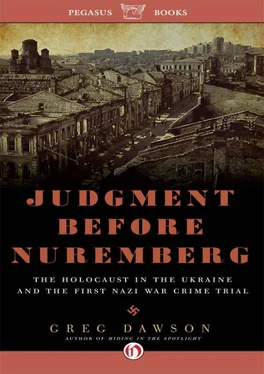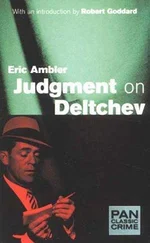“When somebody comes to me and says, ‘I can’t build tank ditches with children or women—that’s inhumane, they’ll die doing it,’ then I must say: ‘You are a murderer of your own blood, because if the tank ditches aren’t built, then German soldiers will die, and they are the sons of German mothers. That is our blood.’ Everything else is froth, a fraud against our own people, and an obstacle to earlier victory in the war.”
Himmler’s rhetoric did not fall on deaf ears. It was echoed in marching orders issued by commanders of the hydra-head Nazi killing machine from the Einsatzgruppen mobile murder squads and regular troops of the Wehrmacht to the Feldgendarmerie (military police), Geheime Feldpolizei (Secret Field Police), and Ordnungspolizei (Order Police). Taking his cue from a document titled “Guidelines for the Behavior of Troops in Russia,” General Erich Hoepner issued this directive to the troops of Armored Group 4 in May 1941, a month before Operation Barbarossa.
“The war against Russia is the old fight of the Germans against the Slavs—the defense of European culture against the Muscovite-Asiatic flood, the repulsion of Jewish Bolshevism. The goal of this fight must be the destruction of contemporary Russia and therefore must be conducted with enormous violence. Every combat action, in its conception and conduct, must be governed by an iron will to pitiless and complete annihilation of the enemy.”
Despite his best and most strenuous efforts, Himmler was not able to erase the conscience of all German soldiers and officers, who were men first and Nazis second. Some retained enough basic decency to have moral qualms about the unspeakable things they witnessed and were ordered to do.
In August 1941 in the village of Byelaya Tserkov, about fifty miles from Kiev, the Germans and their local henchmen shot several hundred Jewish men and women at a firing range near the village. Before the shootings, children of the condemned Jews were locked in a building nearby without food or water or toilets. A German soldier who heard loud crying and whimpering alerted two military chaplains who entered the building and filed a report.
“We entered the house and found in two rooms some ninety children, from a few months to five, six, or seven years old. There was no kind of supervision. The rooms were in a filthy state. Children lay or sat on the floor, which was covered in their feces. There were flies on the legs and abdomens of most of the children, some of whom were only half dressed. Some of the bigger children were scratching the mortar from the wall and eating it. The stench was terrible. The visiting soldiers were shaken, as we were, by these unbelievable conditions and expressed their outrage over them. One of them said that he himself had children at home.” [3] Ernst Klee, Willi Dressen, and Volker Riess, The Good Old Days: The Holocaust as Seen by its Perpetrators and Bystanders (The Free Press/Macmillan, 1991).
Afterward, the chaplains learned that other children had been taken from the building earlier and shot, and that those who remained soon would share the same fate. The chaplains’ report on conditions in the building and their plea for mercy for the children went to the Catholic divisional chaplain, who sent it up the line to Sixth Army Field Marshal von Reichenau, who essentially washed his hands of the matter. “It would have been far better if the report had not been written at all,” he wrote.
Col. Paul Blobel, the Einsatzgruppen commander who later supervised the massacre at Babi Yar, ordered SS-Obersturmfuhrer August Hafner to carry out the death sentence which von Reichenau had refused to lift. Hafner objected, noting that many of his men had small children. It was decided that Ukrainian militia would do the job. The children were taken to the edge of the village near some woods.
“They were lined up along the top of the grave and shot so that they fell into it. The Ukrainians did not aim at any particular part of the body. Many children were hit four or five times before they died. The wailing was indescribable. I shall never forget the scene throughout my life. I particularly remember a small fair-haired girl who took me by the hand. She, too, was shot later.” [4] Klee, Dressen, Riess, The Good Old Days , 154.
A key weapon in the first weeks of the Nazi push into Ukraine was the igniting of pogroms by Ukrainians against Jews in their midst, especially in western Ukraine areas annexed by the Soviets in 1939, where there were centuries-old traditions of pogroms sparked by hardly anything at all. Some Ukrainians were acting on longfestering anti-Semitism that had roots as old as Luther in Germany; others had swallowed propaganda and saw Jews as agents of Bolshevism and the hated Stalin, who had inflicted mass starvation on Ukraine in the 1930s as punishment for resistance to his new system of collective farming. Sometimes the Germans covertly organized killing parties; often they simply stepped aside and allowed human nature, and historical precedence, to take its grisly course.
For sheer savagery, if not scale, nothing exceeded the scene at the garage complex of an agricultural center in Kovno, a Lithuanian border village in the direct path of the Nazi invasion. A German officer described the events, witnessed by a large crowd of men, women, and children from the village.
“A blond man of medium height, age about twenty-five, stood leaning on a wooden club, resting. The club was as thick as his arm and came up to his chest. At his feet lay about fifteen or twenty dead or dying people. Water flowed continuously from a hose washing blood away into the drainage gully. Just a few steps behind this man some twenty men, guarded by armed civilians, stood waiting their execution. In response to a cursory wave the next man stepped forward silently and was beaten to death with the wooden club, each blow accompanied by enthusiastic shouts from the audience.” [5] Klee, Dressen, Riess, The Good Old Days , 28.
Earlier I wrote that Sherman “famously” warned Atlanta leaders that “war is hell.” Famously—but not actually. Sherman “probably never said these words, and if he did, he certainly didn’t while in Atlanta,” Marc Wortman wrote in The Bonfire: The Siege and Burning of Atlanta. The clarion aphorism has become part of the myth that Sherman alone razed Atlanta, though Confederate defenders also lit a “monumental bonfire,” he wrote.
What Sherman actually said in a letter to the mayor and city council denying their plea to lift his expulsion order for civilians was this: “You cannot qualify war in harsher terms than I will. War is cruelty, and you cannot refine it.” Yet he did. In the same letter, he offered his “services” to make the exodus of civilians out of harm’s way “as easy and comfortable as possible.” And he concluded, “My dear sirs, when peace does come, you may call on me for anything. Then I will share with you the last cracker, and watch with you to shield your homes and families against danger from every quarter.”
In September 1943, Himmler ordered the retreating German army “to leave behind in Ukraine not a single person, no cattle, not a ton of grain, not a railroad track. The enemy must find a country totally burned and destroyed.”
Not a single cracker.
By “refine,” Sherman meant to make more gentle and civilized, or at least less barbaric and violent. But refine can have an alternate meaning: to polish and perfect—removing all flaws and impurities. Even the faintest gesture of mercy or restraint—a cracker for the vanquished—would be regarded by Himmler as a soft, corrupting flaw in the waging of total war.
One Confederate soldier called Sherman’s assault on Atlanta “a grand holocaust of death.” Across the ocean, stirring in the belly of Germany, was a far grander holocaust—a hard, diamond-like refinement of war free of the impurities of mercy and conscience that stop a man from smashing the head of a child against a rock or running it through with a bayonet.
Читать дальше












